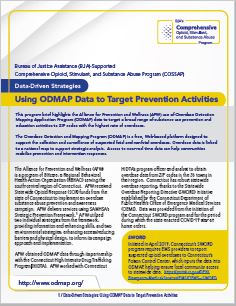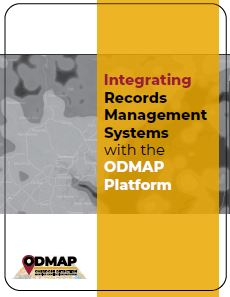The timely collection, sharing, analysis, and dissemination of fatal and nonfatal overdose and naloxone administration data enables communities to develop tailored intervention strategies targeting specific geographic areas or high-risk individuals.
In 2017, the Washington-Baltimore High Intensity Drug Trafficking Area (HIDTA) launched a free, user-friendly mobile tool known as the Overdose Detection Mapping Application Program (ODMAP) to easily and quickly track the locations of suspected fatal and nonfatal overdoses and the administration of naloxone. ODMAP provides overdose data within and across jurisdictions to support community-based efforts to mobilize responses to overdose spikes.
The ODMAP Initiative, co-funded by the Bureau of Justice Assistance and Centers for Disease Control and Prevention, supported eight states in achieving statewide adoption of ODMAP. This initiative also enhanced the ability of local communities within these selected states to effectively leverage ODMAP data, identify “hot spots” and trends of concern, and develop coordinated public safety, public health, and behavioral health intervention strategies.
The ODMAP Initiative began in September 2019, and all sites concluded their activities by July 2023.
Reducing overdose deaths by supporting statewide adoption of ODMAP and strengthening the ability of communities to leverage the data to develop coordinated public safety, public health, and behavioral health intervention strategies.

Using ODMAP Data to Target Prevention Activities
This program brief highlights the Alliance for Prevention and Wellness (APW) use of Overdose Detection Mapping Application Program (ODMAP) data to target a broad range of substance use prevention and education activities to ZIP codes with the highest rate of overdoses.
View Document
Integrating Records Management Systems with the ODMAP Platform
This document provides an overview of how to connect records management systems (RMS) to ODMAP via an Application Program Interface (API), considerations in developing the API, and lessons learned from the Data Integration Project by Columbus Public Health.
View the resource
The Overdose Mapping Application Program (ODMAP) Platform and User Guide
The Overdose Mapping Application Program (ODMAP) Platform and User Guide provides a comprehensive overview of the ODMAP platform, examples of community application, and resources to support ODMAP adoption.
View the guide